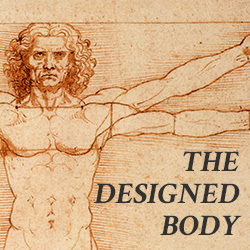 Evolution
Evolution
 Medicine
Medicine
Muscles and Nervous System: Keeping the Body Moving

Editor’s note: Physicians have a special place among the thinkers who have elaborated the argument for intelligent design. Perhaps that’s because, more than evolutionary biologists, they are familiar with the challenges of maintaining a functioning complex system, the human body. With that in mind, Evolution News is delighted to offer this series, “The Designed Body.” For the complete series, see here. Dr. Glicksman practices palliative medicine for a hospice organization.
 To be able to sit and read this paragraph, your body must perform several actions all at once. Sitting upright requires continuous coordination of the spinal muscles and limbs to maintain your body’s position in space. Scanning these words involves not only the neck and eye muscles, but also the vestibular apparatus to keep the picture in proper position as you move your head and your eyes track along the page. Your eyes must process the light reflecting off the screen and convert it into something called vision. To understand what you are reading, your brain must recognize the small dark figures it sees, identify them as words to be interpreted, and transform them into ideas.
To be able to sit and read this paragraph, your body must perform several actions all at once. Sitting upright requires continuous coordination of the spinal muscles and limbs to maintain your body’s position in space. Scanning these words involves not only the neck and eye muscles, but also the vestibular apparatus to keep the picture in proper position as you move your head and your eyes track along the page. Your eyes must process the light reflecting off the screen and convert it into something called vision. To understand what you are reading, your brain must recognize the small dark figures it sees, identify them as words to be interpreted, and transform them into ideas.
So how does your body do it? The simple answer is that your nerves and muscles, working together, let you read and reflect on this paragraph and do much more besides. But that only answers the what, and not how. In my next several articles, I will explain how neuromuscular function allows the body to deal with the laws of nature. To begin with, we will briefly explore how nerve and muscle cells work at the molecular level and are organized within the body.
At rest, all human cells carry a negative charge inside and a positive charge outside the plasma membrane, creating what is called the resting membrane potential. Nerve cells (neurons) and muscle cells (myocytes) are excitable, meaning that when adequately stimulated, they can reverse this resting membrane polarity. By allowing sodium ions (Na+) to rapidly enter through specific channels, they make the inside positive relative to the outside. This process is called depolarization.
When depolarization of the neuron takes place, the electrical message moves along the cell and causes calcium ions (Ca++) to enter as well. The sudden increase of Ca++ ions in the cytosol of the neuron signals it to release its neurotransmitter. The neurotransmitter passes out of the neuron and affects either another neuron or a myocyte, which may be stimulated or inhibited.
When a muscle cell is adequately stimulated and Na+ ions suddenly enter to cause depolarization of its membrane, it releases Ca++ ions from a reservoir called the sarcoplasmic reticulum. The sudden increase in Ca++ ions within the cytosol of the myocyte enables the contractile proteins, actin and myosin, to interact. This interaction causes muscle contraction. This is relatively short-lived, because the Ca++ ions are soon after pumped back into the sarcoplasmic reticulum, causing actin and myosin to disengage and contraction to cease.
Each skeletal muscle is made up of many individual myocytes that run parallel to each other and are grouped in bundles. At each end of these bundled muscle fibers there is fibrous tissue called the tendons that attach the muscle, usually to two different bones, across a joint. The end of the muscle attached to the bone that stays still during contraction is called the origin and the one that moves one bone toward the other is called the insertion.
Most joints have complementary pairs of muscles that allow it to be moved back and forth along a particular plane. This is how the body uses its muscles. For example, the origin of the biceps in the upper arm is attached to shoulder blade (scapula) just above the shoulder joint, while the insertion is attached to the inner aspect of the forearm. When the biceps contracts, this makes the forearm move toward the shoulder, flexing the elbow and bringing the fist up in the muscle-man pose. Try it and see: with the palm of your hand turned toward your face, maximally flex your elbow and put your other hand on your biceps to feel it contract.
In contrast, the origin of the triceps is located on the scapula just below the shoulder joint and its insertion is attached to the back of the elbow. When the triceps contracts this makes the forearm move away from the upper arm, straightening (extending) the elbow and moving the fist away from the shoulder. Try it and see: while maximally extending your elbow put your hand on your triceps and feel it contract.
The musculoskeletal system consists of over two hundred bones with about six hundred muscles attached to them, usually across a joint consisting of two or more bones. The bones that make up each joint can usually be moved in two or more directions by pairs of complementary muscles, like the biceps and triceps flex and extend the elbow. It is through controlled contraction and relaxation of the muscles that the bones can move to allow the body to breathe, move around, and manipulate things.
The nervous system is organized like a military operation in that a general and his staff must receive information from the reconnaissance team about where the enemy is located and what it is doing. This information is used by headquarters to help make decisions about strategy and to formulate the orders being sent out to the troops. But things don’t end there. Headquarters has to constantly be kept informed of what is going on in the field so it can adjust to an ever-changing situation.
Similarly, the body’s nervous system is divided into the central and peripheral nervous systems. The peripheral nerves have sensory neurons bundled within them that send information about what is going on inside and outside the body to headquarters. They also have motor neurons bundled within them, which take the orders from headquarters and tell the muscles what to do. The central nervous system, consisting of the brain and the spinal cord, is the headquarters where the sensory information is received, analyzed, and compared with other information. Then orders are sent out to perform coordinated actions that are purposeful and goal directed.
In general, the spinal cord organizes the sensory messages that it receives from the peripheral nerves and sends them to the brain. It also organizes the motor messages from the brain and sends them to the various regions of the body by way of the peripheral nerves. But since the laws of nature (like gravity) wait for no man, the central nervous system uses specific, quick-acting reflexes that work through the spinal cord and the brainstem to prevent injury or to maintain the body’s posture while performing goal directed activities. This is how the body protects itself from the forces of nature so it can survive.
Now you understand how the nerve and muscle cells work at a molecular level and how they are organized within the body. Next time we will look at some of the sensory devices used to monitor the goings on both inside and outside the body.
Keep in mind that evolutionary biologists would have us believe that the multiple bones making up the numerous joints that can be moved in many different directions by complementary sets of muscles all under nervous control came into being by the forces of nature alone. As an experienced pediatrician has expressed to me in writing, “Dismissing a Creative Intelligence in favor of Darwinism defies any sense of reason, genuine intelligence, or just plain everyday common sense.” I couldn’t have said it better myself.
Photo credit: © 2016 GraphicStock.com.

